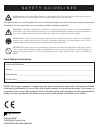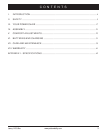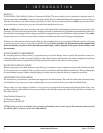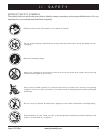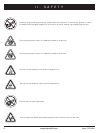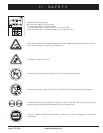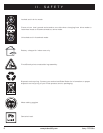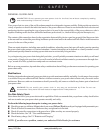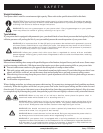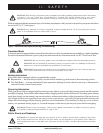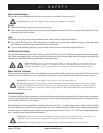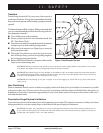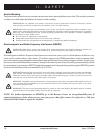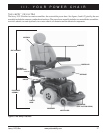
10 www.pridemobility.com Jazzy 1103 Ultra
II. SAFETY
Weight Limitations
Your power chair is rated for a maximum weight capacity. Please refer to the specifications table for this limit.
MANDATORY! Stay within the specified weight capacity of your power chair. Exceeding the weight
capacity voids your warranty. Pride will not be held responsible for injuries and/or property damage
resulting from failure to observe weight limitations.
WARNING! Do not carry passengers on your power chair. Carrying passengers on your power
chair may affect the centre of gravity, resulting in a tip or a fall.
Tyre Inflation
If your power chair is equipped with pneumatic tyres, you should check or have the air pressure checked regularly. Proper
inflation pressures will prolong the life of your tyres and help ensure the smooth operation of your power chair.
WARNING! It is important that 2.4 bar (35 psi) tyre pressure be maintained in pneumatic tyres at
all times. Do not underinflate or overinflate your tyres. Low pressure may result in loss of control,
and overinflated tyres may burst. Failure to maintain 2.4 bar (35 psi) tyre pressure in pneumatic
tyres at all times may result in tyre and/or wheel failure.
WARNING! Inflate your power chair drive tyres from a regulated air source with an available
pressure gauge. Inflating your tyres from an unregulated air source could overinflate them, resulting
in a burst tyre.
Incline Information
More and more buildings have ramps with specified degrees of inclination, designed for easy and safe access. Some ramps
may have turning switchbacks (180-degree turns) that require you to have good cornering skills on your power chair.
! Proceed with extreme caution as you approach the downgrade of a ramp or other incline.
! Take wide swings with your power chair’s front wheels around any tight corners. If you do that, the power chair’s rear
wheels will follow a wide arc, not cut the corner short and not bump into or get hung up on any railing corners.
! When driving down a ramp, keep the power chair’s speed adjustment set to the slowest speed setting to ensure a
safely controlled descent.
! Avoid sudden stops and starts.
When climbing an incline, try to keep your power chair moving. If you must stop, start up again slowly and then accelerate
cautiously. When driving down an incline, set your power chair to the slowest speed setting and drive in the forward
direction only. If your power chair starts to move down the incline faster than you anticipated or desired, allow it to come
to a complete stop by releasing the joystick, then push the joystick forward slightly to ensure a safely controlled descent.
WARNING! When on any sort of an incline or decline, never place the power chair in
freewheel mode while seated on it or standing next to it.
WARNING! When climbing an incline, do not zigzag or drive at an angle up the face of the
incline. Drive your power chair straight up the incline. This greatly reduces the possibility of
a tip or a fall. Always exercise extreme caution when negotiating an incline.
WARNING! You should not travel up or down a potentially hazardous incline (i.e., areas
covered with snow, ice, cut grass or wet leaves).
WARNING! Never travel down an incline rearward. Doing so may cause the power chair to
tip. Always exercise extreme caution when negotiating an incline.
WARNING! If your power chair is equipped with a reclining seatback, do not attempt to
negotiate inclines with the seat in a reclined position. Do not attempt to negotiate obstacles
with the seat in a reclined position unless an attendant is present to help stabilise the
chair. Failure to heed could result in the power chair tipping over.



